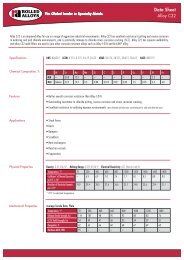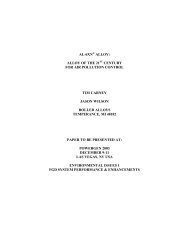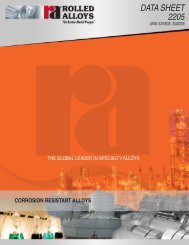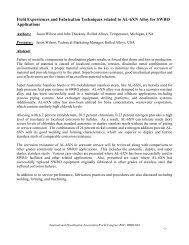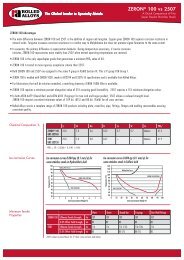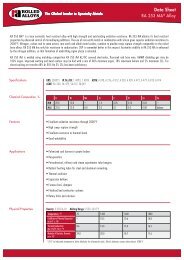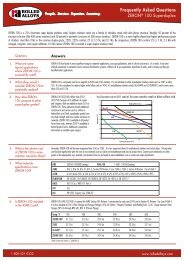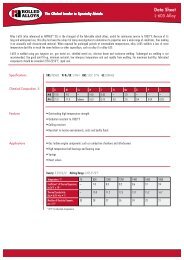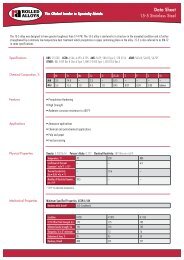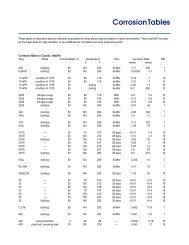Alloy Performance Guide - Rolled Alloys
Alloy Performance Guide - Rolled Alloys
Alloy Performance Guide - Rolled Alloys
Create successful ePaper yourself
Turn your PDF publications into a flip-book with our unique Google optimized e-Paper software.
People. Service. Expertise. Inventory.High Temperature<strong>Performance</strong> <strong>Guide</strong>Least GreatestCondition Not Suggested Good Better BestStrength 446 600, 309, 310 RA330 RA 602 CA, RA333,800H/AT, 601, RA 253 MAThermal Shock (A) 446, 800H/AT 310, 309 RA 253 MA, 601, 600 RA333, RA330Oxidation – 309, 800H/AT, 446 RA330, 310, 600,RA 253 MARA 602 CA, RA333,601Carburization 446, 321, RA 253 MA 310, 309, 800H/AT RA330 RA333, 600, 601RA 602 CAOxidizing Sulfur(SO 2 , SO 3 ) (E) 600 RA 602 CA, RA333 601, RA330, 800H/AT 446, 310, 309,RA 253 MAReducing Sulfur 600, 601, RA333, RA330, 347 309, 310, 556 446(H 2 S) (C) 800H/AT, RA 253 MAHot HCl Gas(Above The Dew Point)446 RA333, RA330 RA 602 CA, 601 200Molten Metals (D)Cu (E) , Zn, Mg600 309, 310,316 (zinc)AL-6XN,(in zinc) Duplex SS446, 430, 410(A)Good thermal shock or fatigue strength requires fine grain size. Materials which are grain-coarsened to maximize creep - rupture strength do so at the expense of thermal fatigue strength.(B)Conditions underneath deposits may be reducing, even though the atmosphere itself is oxidizing. (C) High chromium and low nickel contents are necessary for any degree of resistance tohigh temperature reducing, sulfidizing (H 2 S) environments. (D) In general, the higher the nickel content, the more rapid the attack. Molten aluminum quickly dissolves all commercial alloys.(E)Only the ferritic alloys, such as 430 or 446, withstand copper. All austenitics are attacked intergranularly. Duplex grades have shown good resistance. This chart is intended as guidance forwhat alloys might be tested in a given environment. It must NOT be used as the major basis for alloy selection, or as a substitute for competent corrosion engineering work.Wet Corrosion<strong>Performance</strong> <strong>Guide</strong>Environment Not Suggested Good Better BestChlorides(pitting, crevicecorrosion)Chloride StressCorrosion CrackingHydrochloric Acid304L <strong>Alloy</strong> 20, 316L,LDX 2101, 600304L, 316L LDX 2101, 904L, 2205,317LTitanium (b) , 600, <strong>Alloy</strong>20, 2205, LDX 2101,317LHydrofluoric Acid 200, 600,2205, etc.200 (a) , 400 (a) ,625, ZERON 100C-276, C22, 686,400 (N 2 purged)Sulfuric Acid Titanium, 600 316L, 317L, LDX 2101,2205Phosphoric Acid(commercial)Nitric Acid 904L, AL-6XN, 200,400, 600Caustic 304L, 316L, 317L,Tantalum400 (a) , 2205, 317L AL-6XN, 625, C-276,Titanium, C22, 686,ZERON 100AL-6XN, <strong>Alloy</strong> 20,ZERON 100400, 600, 625, 686,C-276, C22C22, C-276, 686 Zirconium (a) ,HASTELLOY ® B-2 (a) ,Tantalum, Titanium (b)400 (a) , Silver (a) Gold, PlatinumAL-6XN, 625200, 400, 316L, 317L 904L, 2205 AL-6XN, <strong>Alloy</strong> 20,ZERON 100304L, <strong>Alloy</strong> 20, 2205,ZERON 100<strong>Alloy</strong> 20, 2205,LDX 2101, ZERON 100<strong>Alloy</strong> 20, C-276,Tantalum, ZERON 100G-30, 625625 Zirconium, Tantalum600, 625, 400, 686,C22, C-276200 (a)(a)Presence of oxygen or oxidizing salts may greatly increase corrosion. (b) Titanium has excellent resistance to hydrochloric acid containing oxidizers such asFeCl 3 , HNO 3 , etc. However, titanium has very poor resistance to pure, reducing, HCl. This chart is intended as guidance for what alloys might be tested in agiven environment. It must NOT be used as the major basis for alloy selection, or as a substitute for competent corrosion engineering work.9<strong>Rolled</strong> <strong>Alloy</strong>s


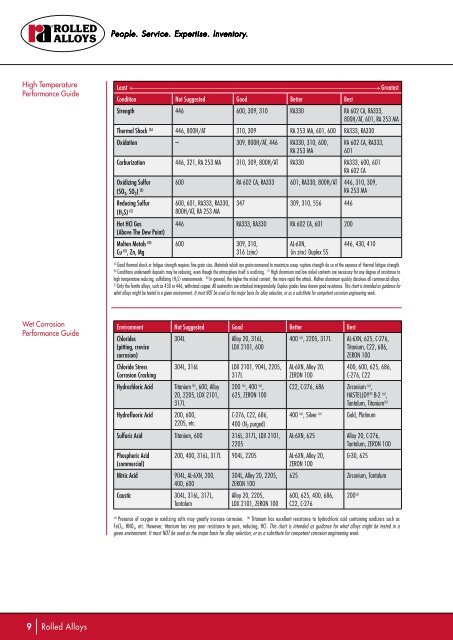
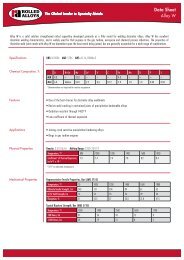
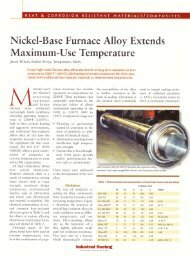
![RA333 Data Sheet [Heat Resistant Alloys] - Rolled Alloys](https://img.yumpu.com/50335849/1/190x245/ra333-data-sheet-heat-resistant-alloys-rolled-alloys.jpg?quality=85)
